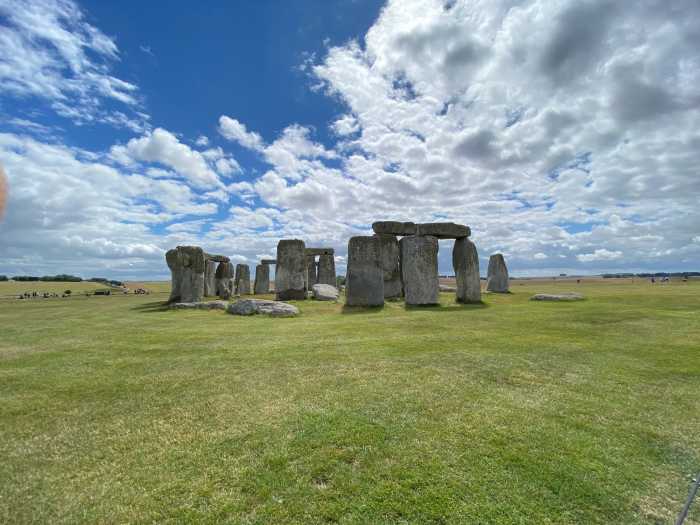
MSN - 10 fantastic facts about Stonehenge
Posted on 26 April, 2021

Written by Stephanie Anthony
One of the most famous landmarks in Britain, the most amazing thing about this unique stone circle in Wiltshire is that we still don't know why it was built. Stonehenge really is one of the biggest historical mysteries, up there with the Nazca lines in Peru and the existence of Atlantis.
A UNESCO World Heritage Site since 1986, Stonehenge has become so popular with visitors that there are now ropes to prevent the public from getting too close and damaging the stones.
Exceptions to this occur during the summer and winter solstice and the spring and autumn equinox when visitors are allowed to stroll between the stones.
However, despite the best efforts of the most intelligent minds throughout history, we don't know how the stones were put there, or why.
But we have figured out some things:
1. It didn't begin as a stone circle
The oldest and original formation of Stonehenge is actually a circular earth bank and ditch, which dates back to 3100 BC. The first stones are believed to have been raised at the site between 2400 and 2200 BC.
2. Stonehenge was built in stages
Over the next few hundred years, the stones were rearranged and new ones added, with the formation we know today being created between 1930 and 1600 BC.
From what we know, the 'completed' design was an outer circle of 30 standing stones called ‘sarsens’, which surround five huge stone arches in a horseshoe shape. There were also two circles made of smaller ‘bluestones’ – one inside the outer circle and one inside the horseshoe – as well as four ‘station stones’ positioned outside the central monument.
3. Salisbury Plain was sacred long before Stonehenge
Stonehenge was not the first monument erected in the area, in fact three large timber posts onsite date to 10,500 years ago. A number of hidden Neolithic shrines have also been discovered.
4. Some of the stones are from 150 miles away
The stone circle is made of two types of stone - bluestones and sarsen stones. The lighter bluestones weigh about 3,600kg each, while the bigger sarsen stones each weigh a whopping 22 tonnes.
The sarsen stones were hauled to the site from 20 miles away, but the bluestones have been traced to the Preseli Hills 150 miles away in Wales. Although archaeologists have theories on how the stones were transported, such as using sledges and making rafts to float the stones along rivers, we still don't know for sure.
5. The Slaughter Stone is red from rust, not blood
The Slaughter Stone is a sarsen stone lying flat with stained red markings caused by rain acting on iron. No evidence of human sacrifice has been uncovered at Stonehenge so its name is perhaps misleading.
It is located just inside the entrance of the henge between the Heel Stone and the Stone Circle. One theory is that this stone is the last remaining of up to three stones that would have been arranged for their own alignments across the entrance.
6. Stonehenge was decorated with carvings
Four of the sarsens at Stonehenge were adorned with hundreds of carvings depicting axe-heads and a few daggers. They appear to be bronze axes of the Arreton Down type, dating from about 1750–1500 BC. Perhaps a symbol of power or status within early Bronze Age society - there are also theories that they were related in some way to nearby round barrow burials.
7. It’s not a henge
There are many henges in Britain, but you can’t count Stonehenge among them. The term describes a raised earthwork with an internal ditch; Stonehenge’s ditch is outside its earthwork, meaning it isn’t a true henge. Avebury, several miles to the north, is probably the most famous real henge.
8. The site was built with a sophisticated understanding of mathematics and geometry
Stonehenge is aligned in the direction of the sunrise of the summer solstice and the sunset of the winter solstice. For that reason it is believed to be something to do with astronomy.
In 1963 American astronomer Gerald Hawkins proposed that Stonehenge had been constructed as a 'computer' to predict lunar and solar eclipses; other scientists have also attributed astronomical capabilities to the monument.
More farfetched theories speculate that Stonehenge is a model of the solar system constructed by ancient alien visitors.
9. Stonehenge was a cemetery
We know that's what it started out as, at least. The 56 pits or 'Aubrey holes' in the area are now known to have housed the remains of at least 64 Neolithic people. These would have been laid to rest before the stones were raised.
10. A number of ley lines cross in the centre of Stonehenge
Many people believe that a grid of earth energies circles the globe, connecting important and sacred sites such as Stonehenge, the Egyptian Pyramids, and the Great Wall of China.
If you plot these and other sites on a map, a curious thing becomes apparent: Many of them can be connected by straight lines. Ley lines are a natural magnetic phenomena that cross the countryside. Ancient monuments often are sited at the intersection of such ley lines.
Stonehenge is positioned at the centre of a hub, or network, of ley lines, - as such Stonehenge is thought of as a place of power, or even believed to be a portal.
To read the original post, please visit: www.msn.com/en-gb/travel/news/10-fantastic-facts-about-stonehenge/ar-BB1daOZg?ocid=iehp
Tags:



